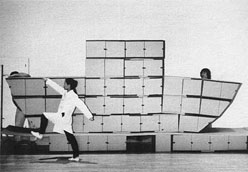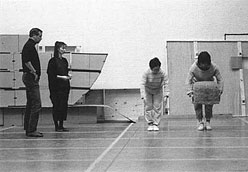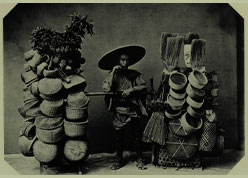

THE CIVIL WARS: THE AMERICAN SECTION
The design concepts were finalized for the remaining plays, and Jun Matsuno began his work as the set designer. In the late summer of 1983 Suzushi Hanayagi was selected as the choreographer. A second series of meetings took place in Tokyo in January and February of 1984 during which further plans were made. In the year since the first workshop in Tokyo, many notebooks have been filled with concepts and sketches by Wilson and Byrne. Myriad ideas shared by the collaborators have been reviewed constantly by Wilson. Accepting, rejecting and adjusting this input, he remains, at all times, the final arbiter of decisions.
Over a period of months in 1983, Walker Art Center and the Guthrie Theater arrived at decisions which led to their cooperation in producing the Knee Plays as the American section for the CIVIL warS. Adelle Lutz conducted auditions in Minneapolis, New York, Los Angeles and other American cities to select the dancers. The audition notices called for male or female actors or dancers and a background in Asian dance was recommended, but not required. The result is a company of eight dancers of widely diverse ethnic backgrounds reflecting the cultural diversity of the CIVIL warS. On March 26, 1984 the company, including Miss Hanayagi from Osaka and Mr. Matsuno from Tokyo, began the final workshop program in Minneapolis.
The Music
Byrne’s first concepts for the music were suggested by the percussive qualities of Japanese Taiko drums and Japanese claves, and he worked with a number of musicians in a recording studio while in Tokyo. At the time of the Tokyo workshop decisions had been reached to produce the Knee Plays in Minneapolis. Byrne began to revise his thoughts, choosing instead to develop some of the music from traditions of American jazz and gospel hymns, forms of music that emerged from the American south. Of particular interest to him were the marching bands of New Orleans whose celebrated musicians carry their funereal spirituals into the streets. Byrne developed some of the music with the Dirty Dozen Brass Band during several visits to New Orleans in the winter of 1983-84. This music would provide a startling resonance with other scenes of the opera in which the American Civil War would be evoked through tableaux of battlefields and appearances by Abraham Lincoln and Robert E. Lee.
In addition to the jazz scores, Byrne has written new works for a brass ensemble which draw from his own language of music. His crisp, percussive style, familiar in his score for Twyla Tharp’s “The Catherine Wheel,” has been set aside in favor of harmony and melody in the remainder of the scores for the Knee Plays.
These lyric passages of chordal cadences for brass ensemble were composed with a variety of tempi and syncopation. No sequence was given to the scores as they were written. Wilson and Byrne chose to set each song to each play as the choreography emerged during the final workshop.
